Note: In December 2024, GUE changed the Fundamentals class by splitting it into two classes, one for recreational divers and one for technical divers. Prior to this, the "fundies" class was combined and you could either pass with a 'Recreational' classification or a 'Technical' classification based on diving single tank or double tank and the quality of your buoyancy and trim control. The experience I describe below relates to the pre-2025 version of GUE Fundamentals, but should be generally applicable for classes after 2024.

What is "Fundies"?
In short: It's how previously trained Open Water divers "cross over" into the GUE system.When you pass the Recreational version of Fundies you are issued a certification/card with the equivalent of an Open Water Diver (EN 14153-3/ISO 24801-2) and the use of Nitrox (ISO 11107). Given that other agencies do not hold Open Water divers to the same quality standard that GUE does, they don't recognize those certifications from other agencies for use within their training program.
Longer answer: As a recreational diver, it is the single best dive training you can take. I say that with no exception or reservation. There are many Fundies trained (pass or not) divers who take the class simply to be a better diver and have no intention of ever continuing in the GUE system. Do you want to know exactly why you can't nail your buoyancy and trim on your own? Do you want to see what it's like to truly dive in a team? Do you want someone to watch you up close and critique your every move?
Example: My instructor gave me feedback on how I was grabbing my primary regulator when I was doing a regulator in/out drill. She asked me to rotate the grip of my hand by about 15 degrees so that when the regulator came out, it would be naturally pointing down and not prone to free flow. Was I doing it "wrong"? No. Was there a "better" way? You know what...she was absolutely correct. That's the level of training and feedback you get.
Though many of the skills may be considered by some divers as "overkill" for a recreational dive looking at pretty fish on a drift of 40ft in warm water...GUE's program has been designed "with the end in mind". Once you learn the basic techniques and procedures, they do not change as you move forward into the more advanced classes such as Tech and Cave. Any GUE diver of any level knows how the other GUE diver is going to dive, what procedure they will follow and what equipment they will be using.
How much does it cost?
That depends....however, there is generally three expenses involved:- Registration with GUE
- Tuition for the class itself
- The expenses of the instructor, including travel and hotel - It is split between the students and you will pay this after the class regardless of pass or not.
If I had to describe the content and the 4 days; it's like taking Open Water, Nitrox, Science of Diving, Navigation, Night & Limited Vis, Drysuit and Peak Performance/Buoyancy all at once.
What equipment do I need?
Taking into account the $1,500 for the training and possibly an additional $1000 for specific equipment they require, taking Fundies can be a financial blocker for many people...it's a DIR like system so you must dive with the equipment they require. No...you can't dive in a jacket style bcd. However, you may be able to rent all of this equipment from your local dive shop!Because I was already diving with this type of equipment after doing my own research and product selection prior to even knowing about GUE, I did not need any new equipment to take the class. You should reach out to your instructor to confirm everything you need to bring (if they haven't already told you) and you can also confirm the style/make/model you are bringing.
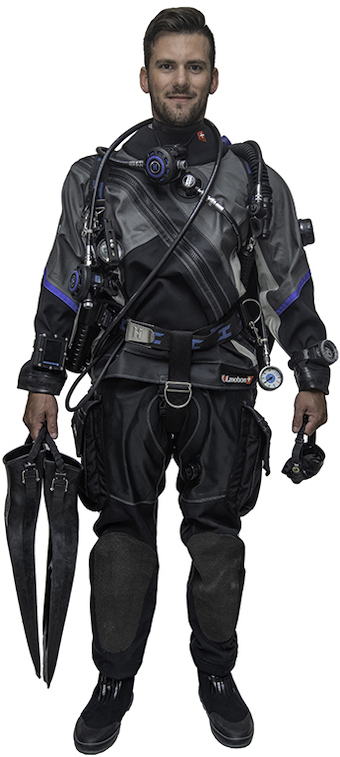 For a Recreational Pass, you will likely need:
For a Recreational Pass, you will likely need:- Backplate and Wing with a continues harness (no breaks for quick adjust buckles) routed in a DIR configuration
- Crotch strap needs to be a single strap (no breaks for quick adjust buckles)
- 5 D-Rings and only 5 D-Rings (left/right chest, left hip, butt, crotch)
- "technical" style fins
- Primary and Backup Mask (preferably with Neoprene straps)
- Wetsuit or Drysuit, with pockets on each thigh. If wetsuit, bring "Tech Shorts".
- Appropriate number of tanks, be mindful of where/how you will get fills
- Compass
- Dive Computer (your instructor will likely request you remove any Air Integration modules so you get used to using your SPG)
- Regulator package with analog SPG, long hose primary and necklaced secondary
- Primary Light and possibly a Backup Light (you may be required to use "turn on" instead of "click on" lights)
- Canister light is optional and not required or advised for those going for a Rec PASS (it's just additional task loading)
- If not diving with a canister light, using a "long hose stick" to simulate it's use and a way to wrangle the long house would be useful
- dSMB and spool with 100ft of "cave line"
- Wetnotes (I never used them on a dive, but they are part of the "standard" pocket contents)
How "hard" is Fundies?
Very. The most intense dive training I've ever had...and that's saying something given how many classes I've taken. If you want a fist bump and a "that a boy" when you clear your mask without freaking out...that's not this class. You are going to get honest and direct feedback both good and bad. They will be kind but direct, bring your big kid pants with you and leave your ego in the car. After the first dive you will realize just how much you don't know. It's not about being perfect to pass...it's about getting better. The bar is set very high...and if you want to actually improve that is what you should want.My advice before you take Fundies
- Have a fitness routine for at least a few months before you go...I decided to take the class at the last minute and I was tired every evening. Particularly some kind of cardio.
- Make sure you can pass BOTH swim tests. Those are easy to practice on your own.
- Eat bananas or have some kind of cramp prevention routine...I had leg cramps starting at the end of Day 2.
- Stay hydrated...have water in your hand every minute you are not diving.
- If possible, get a class with tandem instructors, it will cost a bit more...but so worth it.
- If you think you want a "tech pass", be VERY sure you are ready. The standard is significantly harder than the "Rec Pass" and involves additional task loading with all skills being conducted with a canister light on the left hand using a Goodman handle and in an appropriate double tank configuration with exceptional buoyancy control and trim. You may want to consider finding a local GUE instructor or prior Technical Pass diver and just going on a fun dive with them...they'll tell you if you are ready.
What does the 4 day class look like?
Every class will cover the same material. However, depending on your instructor, dive location and (frankly) the skills of your fellow students...on which day you do something may be different. For example, we did the swim tests on day 2. We could have done them on day 1. We did one dive on day 1, we could have done 2 dives but the onsite air fill station was closed by the time we surfaced from the first dive. etc...My Fundies class was tandem taught by Emőke Wagner and Francesco Cameli. Emőke is a world class cave explorer. Francesco is a world class wreck / technical diver. Over the 4 days we spent a cumulative 6 hours underwater under constant training and feedback, with the longest single non-stop dive of 83 minutes. Nearly double my average dive length to date as a recreational diver. All together the class constituted a 16% increase of my CAREER time under water ...over 4 days. It is intense to say the least. You have to remember that every one of these dives was under constant supervision and involved new and ever more complex task loading. This isn't a quiet drift dive looking at pretty fish.
When you read what the class entails below...you may say to yourself...but I learned about all that in my Open Water class!....true...but did you do it in perfect trim and buoyancy? And did you do it while calm, with precision and while task loaded? This is why the Fundies class is so well regarded in the industry. Most students cannot meet the standard on their first attempt, even those with hundreds of dives and advanced technical certifications from other agencies. Remember how I said this class was the equivalent of an Open Water certification...yet the majority of currently certified Open Water divers wouldn't pass this class! That should tell you something about the quality and expectation of this class. To be honest...I went into the class expecting not to pass and I would have been okay with that. That might have been a good thing.
Day 1 - Thursday
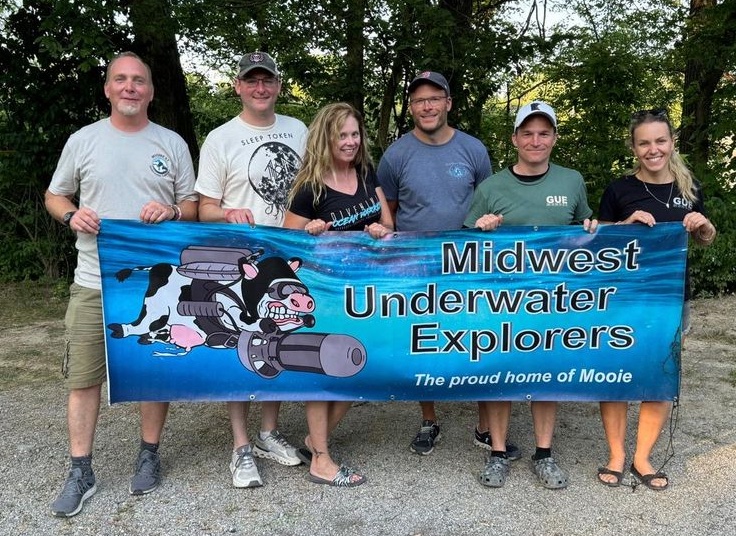
- Paperwork and Introductory class session
- Gear overview and review
- Gear reconfigs to meet standards and proper fit
- Dive 1
- -- The GUE - EDGE Pre-Dive ceremony
- -- Weight checks (I eventually ended up removing 30% of my normal weight, which was shocking to say the least as I thought I had it dialed in)
- -- Essentially a "Show Me" your current skills dive
- My Feedback:
- -- Keep your head up
- -- Stop with the "happy feet" (my legs/feet are always flittering)
- Additional class session
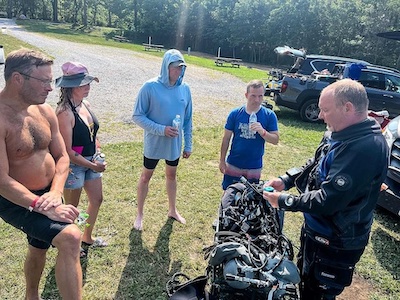
Day 2 - Friday
Emőke knew that I was going to be diving in Lake Michigan in a drysuit and encouraged me to switch to my drysuit for the rest of the class, even though I had less than 10 dives with it.- Class session
- Under water swim test (50ft) (I failed first time / passed second time)
- Open water swim test (300 yards in 14min) (I did it in 6min)
- Nitrox and O2 Analysis session (standard is Nitrox32)
- Dive 2
- -- Continue with improving kicks
- -- Do the "Basic 5" for the first time
- --- Mask Clear
- --- Mask Removal / Return
- --- Regulator Out/In
- --- Switch to Necklaced Regulator and Back
- --- Long Hose Donation
- My Feedback:
- -- Keep your head up (This becomes a pattern)
- -- Keep arms out not "T-Rex arms under your chest"
- Class session
- Dive 3
- Continue with improving kicks
- -- Do the "Basic 5" again
- -- Do valve drill the first time (I failed)
- My Feedback:
- -- Keep your head up (damn it!!)
- -- Keep arms out (damn it!!)
- -- Back kick needs work
- Underwater Video Review (I had never seen myself under water...super cool)
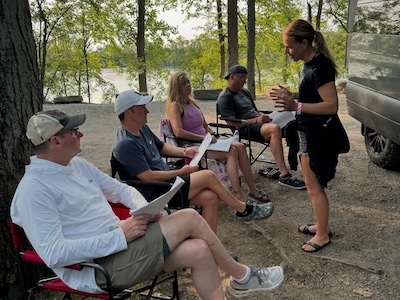
Day 3 - Saturday
- Mid-class evaluation:
- -- Great attitude. Paying attention.
- -- Want to see more team awareness
- -- Need to be more consistent with trim and skills
- -- Rec Pass is still on the table
- Class session
- Dive 4
- *Francesco switched fins with me for this dive to see if that would help with my kicks / cramps
- -- Continue with improving kicks
- -- Do the "Basic 5" again
- -- Do valve drill (I failed...again!)
- -- No mask swim (My buddy was given feedback about not running me into obstacles - hahahah)
- My Feedback:
- -- Keep your head up (damn it!!)
- -- Keep arms out (damn it!!)
- -- Back kick getting better
- -- Both instructors figure that the fins I was using (Deep6) are stiff as a brick as well as my Rock Boots...and both are probably contributing to my cramping and "stiff" fin kicks
- Introduction of the S-drill
- Dive 5
- -- Continue with improving kicks
- -- Do S-drill for the first time
- My Feedback:
- -- Better job with your head (YES!!)
- -- Better job with your arms / trim (YES!!)
- -- Still have "happy feet" but getting better
Day 4 - Sunday
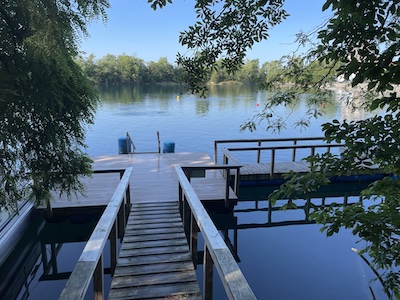 I was mentally and physically exhausted at this point from the prior 3 days and talked to Emőke about possibly not continuing. She encouraged me to continue as I only needed one more dive to complete the class and at least get a "provisional" if not a "pass".
I was mentally and physically exhausted at this point from the prior 3 days and talked to Emőke about possibly not continuing. She encouraged me to continue as I only needed one more dive to complete the class and at least get a "provisional" if not a "pass".
- Final Written Exam (This was a no joke exam with several written portions that required additional pieces of paper to show your work...I passed.)
- Underwater Video Review
- Dive 6
- -- Continue with improving kicks
- -- Do valve drill (I did it!)
- -- Do S-drill again
- -- Do backup mask deployment for the first time
- -- dSMB deployment and controlled ascent for the first time
- My Feedback:
- -- Excellent team awareness
- -- Not enough buoyancy control on the ascent
- Dive 7
- -- dSMB deployment and controlled ascent
- -- dSMB deployment and controlled ascent
- -- dSMB deployment and controlled ascent
- My Feedback:
- -- Much better buoyancy control
Final Feedback
- You PASSED
- Great attitude during the entire class
- Took the feedback without excuse or pushback
- Very glad to see me switch to drysuit on day 2 even though I could have continued in a wetsuit and made it easier on myself
- Excellent teammate with good situational awareness
- Significant and material improvement from day one to day four
- Francesco gave me some ideas for additional buoyancy and "happy feet" training that I can do at any quarry with a platform
Official Final Evaluation Notes
 "Tyler is a very committed diver who greatly improved during the 4 days. He had a very solid performance and acted as an excellent teammate. Tyler developed a solid platform for recreational diving, his kicks are overall nice, drills and procedures are precise and awareness exceeded minimum standards. Trim has to be more consistent especially when task loaded by avoiding fin tips dropping down, and by keeping core tension. Tyler has the tendency to drop his head, he is aware of it. Buoyancy on ascents with and without task load has to be practiced in order to gain more confidence and memory about when and how much gas has to be vented [Tyler: from drysuit]. We recommended changing his fins to more flexible ones like OMS Slipstreams, Hollis F1 or Jetfins. Changing the backplate is also something to consider since waist strap is running too low."
"Tyler is a very committed diver who greatly improved during the 4 days. He had a very solid performance and acted as an excellent teammate. Tyler developed a solid platform for recreational diving, his kicks are overall nice, drills and procedures are precise and awareness exceeded minimum standards. Trim has to be more consistent especially when task loaded by avoiding fin tips dropping down, and by keeping core tension. Tyler has the tendency to drop his head, he is aware of it. Buoyancy on ascents with and without task load has to be practiced in order to gain more confidence and memory about when and how much gas has to be vented [Tyler: from drysuit]. We recommended changing his fins to more flexible ones like OMS Slipstreams, Hollis F1 or Jetfins. Changing the backplate is also something to consider since waist strap is running too low."
